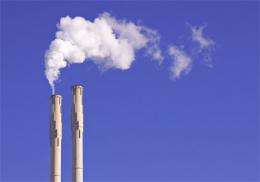Carbon emissions: U.S. fares better when considering climate

(Phys.org) -- The U.S. has long been among the world's worst emitters of carbon dioxide, but when accounting for climate in addition to GDP, it is nowhere near the bottom of that list, according to University of Michigan researchers.
"Increased concern about carbon dioxide emissions has resulted in efforts to create methods for ranking countries according to their emissions," said Michael Sivak, director of Sustainable Worldwide Transportation at the U-M Transportation Research Institute. "Such rankings inform policy decisions on an international scale. The more comprehensive these rankings are, the better our chances of reducing emissions."
Sivak and UMTRI colleague Brandon Schoettle say that some rankings adjust the total amount of emissions to account for the size of each country's population (per capita) and its overall economic output (per GDP). But they believe it's important to go one step further: account for the general heating and cooling demands imposed by the climate of a given country because climate control produces carbon dioxide emissions.
"A system that includes the variable of local climate provides a fairer measure of carbon dioxide emissions," Sivak said. "Our approach involves adjusting the amount of emissions in accordance with the total number of heating degree days and cooling degree days."
Under that method, the U.S. improves from No. 152 out of 157 countries to No. 100 on a per capita, GDP and heating-and-cooling-degree-day basis. Heating and cooling degree days relate to the amount of energy needed to heat and cool buildings. One heating (cooling) degree day occurs for each degree the average daily outdoor temperature is below (above) 65 degrees Fahrenheit.
In a new study in American Scientist, Sivak and Schoettle use three variables for each of the 157 countries: carbon dioxide emissions per capita; emissions per capita and GDP (adjusted for differences in purchasing power between countries); and emissions per capita, GDP and heating and cooling degree days.
Accounting for climate, the researchers found that Finland, Canada, Russia, Norway, Slovakia, Lithuania and Estonia—all cold-weather countries—showed the most improvement among the world's nations. Ethiopia, Guatemala, Malawi, Zambia, Kenya, Peru and Costa Rica—all with mild climates—dropped the most on the list.
Other countries that fared better when using heating-and-cooling-degree days included Britain, Germany, Sweden, China and India. Those that did worse included Australia, Brazil, Israel and Mexico.
The five best countries when climate is considered were Chad, Afghanistan, Mali, Niger and Burkina Faso. The five worst countries were Bosnia and Herzegovina, Turkmenistan, Trinidad and Tobago, Uzbekistan and South Africa. South Africa, the highest emitter, produces about 61 times more emissions than Chad, the lowest emitter.
"Overall, our results suggest that taking climate into account makes a significant difference in how countries fare in carbon dioxide emissions rankings," Sivak said. "Because people respond to the climate they live in by heating and cooling indoor spaces, an index that incorporates climate provides a fairer yardstick than an index that does not."
Provided by University of Michigan















